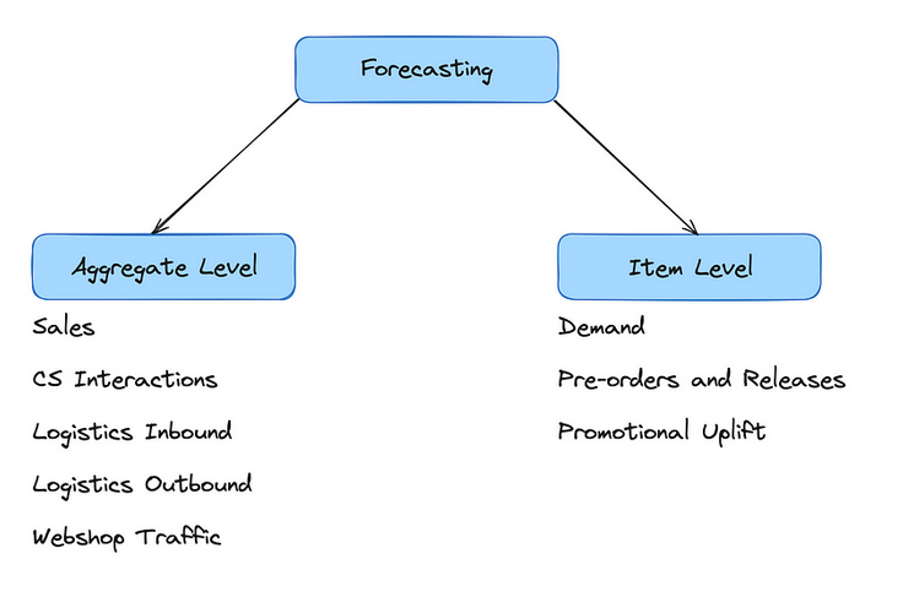Navigating the Future: An Overview of Forecasting at bol

The importance of forecasting
Today’s business landscape is evolving at a pace that we have not seen before. The digital marketplace continues to evolve, either by the development of new technologies (for example, large language models) or a reaction to current events. As such, the ability to predict future trends has become more critical than ever. Having accurate forecasts offers companies the opportunity to gain a competitive edge by making timely, data-driven decisions. Knowing about what is to come, businesses can proactively respond to changing market dynamics and shifting consumer preferences.
It is difficult to make predictions, especially about the future. ~ Niels Bohr/Yogi Berra
Within the realm of e-commerce, businesses can forecast numerous metrics to support decision-making. These include demand for products, website traffic patterns, inventory levels, and even customer behavior. Using time series forecasting, companies can optimize their supply chain management, anticipate seasonal trends, adjust pricing strategies, reduce operational costs, and mitigate risks.
Furthermore, forecasting enables them to allocate resources effectively, thus making sure that products are readily available when and where customers demand them. This helps us offer our customers speedy delivery of the goods they need and someone to pick up their phone call if something goes wrong.
In this article, we will go over a high-level overview of forecasting at bol. We will introduce some of our forecasting projects and explain how we have developed forecasts that are used daily by dozens of business stakeholders. Let’s dive into it!
Team Forecasting
In bol, there are many data science powered teams working on tasks such as recommendation, search, supply chain optimization, fraud detection, pricing strategies, and more. Team Forecasting is one of those.
As a team, we try to streamline the decision-making process for various business teams by providing them with accurate predictions about the future. At the same time, we place a great emphasis on the interpretability of our forecasts. Because many business stakeholders make decisions based on the forecasts, they also feel more comfortable with making those if they understand where the numbers are coming from. That is why we always try to leverage interpretable approaches and also spend time on educating the stakeholders about our approaches to forecasting.
As there are many use cases of forecasting in the company, we have further divided into two sub-teams based on the aggregation level of the forecasts that we are working on. In what follows, we'll explain each of them and their duties in more detail.

Aggregate level forecasts
The primary forecast of this sub-team is the aggregate-level sales forecast. With this project, we forecast the sales for the upcoming X weeks, both on the weekly and daily levels. To give a bit of context around aggregation, one possible level of aggregation could be the sales of the company as a whole. Such a forecast can help with making company-level decisions and working on setting goals and expectations. Another possible level would be sales that come through the warehouses of bol, which is crucial for operations and workforce allocation.
An important common characteristic of most aggregate-level forecasts in our team is that they also depend on the sales forecast (making them downstream forecasts), as sales are often the primary driver of many other metrics that we are forecasting.
This leads us to another crucial forecast, which is the customer support interaction forecast. With this project, we provide an estimate of how many interactions our customer support agents can expect within the next weeks. This forecast is crucial for the business, as we do not want to over-forecast, which would lead to overstaffing of customer support. On the other hand, we also do not want to under-forecast, as that would lead to extended waiting times for our customers.
To make sure that our services (webshop, app) scale well during the peak period (November and December), we also provide a request forecast, that is, how many requests the services can expect during the busy periods.
Lastly, we provide a range of logistics-related forecasts. Bol has multiple warehouses in which we store both our own items, and the items of our partners who would like to use bol’s logistical capabilities to make their business operate smoothly. As such, we provide a few different forecasts related to logistics.
The first one is logistics outbound forecasts, that is, a forecast indicating how many items will leave our warehouses in the coming weeks. Similarly, we provide an inbound forecast, which focuses on items arriving in our warehouses. Additionally, we also provide a more specialized inbound forecast that further divides the incoming items by the type of package they arrive in (for example, a pallet vs a box). That is important as those different kinds of packages are processed by different stations within the warehouses and we need to make sure they are staffed appropriately.
Item level forecasts
The second sub-team focuses on item-level forecasts. Bol offers around 36 million unique items on the platform, and for most of those, we do need to provide demand forecasts. Those predictions are used for stocking purposes. This way, we try to anticipate the needs of our customers and order any items they might require well in advance so that we can deliver it to them as soon as possible.
Additionally, the team provides a dedicated forecast that can handle newly released items and pre-orders. With this forecast, the stakeholders can anticipate how many items will sell one day before the release and within the next month after the release. This way, we can make sure that we have enough copies of FIFA or Stephen King’s latest novel.
Finally, our team also developed a promotional uplift forecast, which helps to evaluate the uplift in sales of a given item based on the price discount and the duration of the promotion. This forecast is used by our specialists to make better, data-driven decisions when it comes to designing promotions.

Centralized forecasting team
At bol, there are two different approaches to structuring data science-powered teams. First, data scientists can be embedded in a product team. In this approach, they are then part of a cross-functional team that works on developing a particular product. Alternatively, a team can be centralized, that is, the team is a standalone entity that provides products for various stakeholders, with the team serving as the owner of those products.
Even though our two sub-teams are mostly working on separate projects, we have decided to stay a single, centralized forecasting team. We made that decision, as we believe that there are many advantages of keeping us together. Below you can find some of the most important ones:
- Unified expertise — Centralization allows us to concentrate time series expertise in one team. This allows us to work in a highly collaborative environment in which all team members can share knowledge, best practices, and insights. All of those lead to a higher overall level of expertise.
- Consistent standards — As a centralized team, it is much easier to establish and enforce consistent standards, methodologies, and best practices when it comes to forecasting.
- Cross-functional collaboration — A centralized team can easily collaborate with various business teams within the organization. This enables us to work closely with domain experts and stakeholders from different areas of the business.
- Strategic alignment — A centralized team is better positioned to align its work with the overall strategic goals of the company. As most of our forecasts are connected to each other, this alignment ensures that data science initiatives are focused on addressing the most critical business challenges and identifying the most promising opportunities.
- Shared infrastructure and tooling — as a team, we have developed an MLOps platform called Delphi. We use this platform to run our ETL processes, deploy ML projects to production, and run dozens of experiments in parallel. The platform became so successful that it is now adopted by multiple teams within the organization.
It is also worth mentioning that even though we are a centralized team, we do not always own the forecasts we build. For that reason, we have also adopted a consultancy approach, in which we work closely with other teams to build forecasts collaboratively. Then, we pass on the finished product along with the know-how, enabling the teams to maintain and further develop the forecasts independently.
Future work
Based on the descriptions above, it might seem that the forecasting landscape of bol is already quite expansive and that the work is almost done. But that is far from the truth!
On one hand, reality changes quite frequently, and the forecasts that we already provide still require a significant amount of work. For example, the COVID pandemic started in 2020, which resulted in a shift in all the patterns that we were used to. Another significant trend shift started in early 2022 with the start of the war in Ukraine. We need to make sure that our forecasts adapt to global events and still provide actionable insights for business teams making decisions based on them.
On the other hand, there is still a lot of potential for brand-new forecasts. We are actively talking to business stakeholders to see if a new forecast could add value to the existing processes. Aside from new forecasts, we are currently working on a short-term flavor of our aggregate sales forecast that quickly adapts to any changes in the sales patterns and helps to plan the daily activities in the warehouses. Moreover, we are experimenting with using item-level embeddings to improve the accuracy of the promotional uplift forecast.
Lastly, the time series forecasting domain is developing at an increasingly rapid pace. That is why there are a lot of new, state-of-the-art approaches being developed for forecasting. As data scientists, we naturally love playing around with the latest and greatest! And if possible, we try to leverage those approaches to further improve our existing forecasts or build entirely new forecasts.
As you can see, there is still quite a bit of potential work ahead of us. And we are currently searching for new colleagues to join us. Are you interested? Please check out the vacancies available on our website. And feel free to reach out in case you have any questions!
Tags
Eryk Lewinson
All articles by me